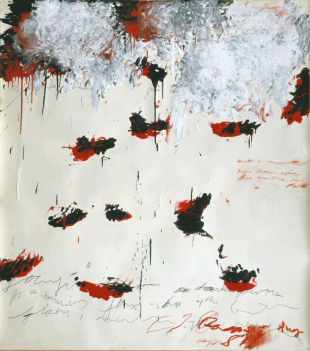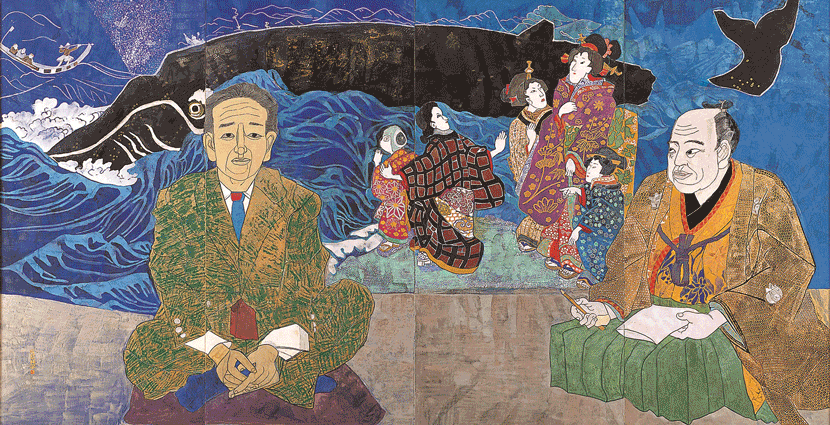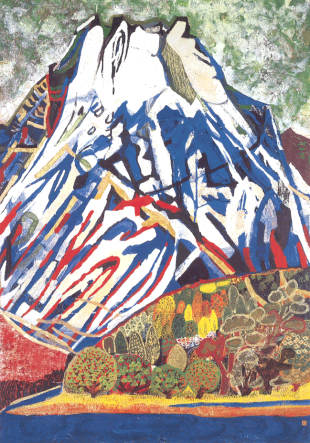This month we’re celebrating two very different artists—different from each other and different from everyone else—who dedicated their lives and careers to powerful self expression.
By Sarah Custen
Kataoka Tamako: The 110th Anniversary of Her Birth
It’s hard to believe Kataoka Tamako lived and worked when she did. Her paintings feel far too radical to be the product of a woman born in Sapporo in 1905. Though her art follows traditional nihonga (Japanese) style, it’s subversive in both subject matter and treatment. The technique may be traditional, but the scenes she portrays are often anything but typical: a woman knitting while her daughter reads manga, an airman so devotedly depicted you can almost read his thoughts, and serpentine blue-green nudes, equal parts medusa and stony victim.
“Her expression was revolutionary in the world of Japanese-style painting at that time,” said MOMAT curator Reiko Nakamura. “She developed her own, unique style.”
It’s a style that is at once feminine and strong, especially in her later years when she favored bold, almost garish, colors and brushstrokes. Scenes of Japanese mountains and countryside in psychedelic hues and trippy, collage-like patterns are an outstanding representation of combined western and eastern artistic influences. Kataoka’s inspirations can be further felt in a display of 30 personal sketchbooks, some of which document a 40-day trip to Europe in 1962, “with her comments and diary to vividly show what kind of Western art she saw,” said Nakamura.
Influential or not, the work calls to mind many western artists: Kataoka’s landscapes evoke Georgia O’Keeffe, and her “Countenance” series is undeniably reminiscent of Warhol’s pop art, yet her work is far from imitative. While much of Japanese art is dedicated to faithful replication, Kataoka’s paintings sing as true, individual expression.
“Japanese-style painters at that time nestled close to the subject,” Nakamura explained. “However, [Kataoka] observed the subject through a filter of her own…hauling it into her own formative sensibility.”
The National Museum of Modern Art Tokyo (MOMAT)
April 7–May 17, 2015
Open Tuesday through Sunday, 10:00–17:00, Fridays 10:00–20:00, closed Mondays
www.momat.go.jp/english/artmuseum/kataokatamako2015.html
Cy Twombly: 50 Years of Works on Paper
American painter Edwin Parker (“Cy”) Twombly Jr’s massive, calligraphic paintings—bright colors smashed and scribbled onto neutral backgrounds–hang in the permanent collections of the Louvre in Paris and NYC’s MoMA. Yet despite the fact that the late Mr. Twombly is a well-known name in Japan, his work has appeared in only a few group shows here, “only two or three pieces at a time,” said Hara Museum curator Atsuo Yasuda. “By assembling such a large number of works in one place, viewers are certain to make new discoveries about Twombly’s art.”

“Petals of Fire”, 1989 144 x 128 cm acrylic paint, oil stick, pencil, color pencil on paper © Cy Twombly Foundation / Courtesy Cy Twombly Foundation
Stemming from an encounter between Hara Museum’s director, Toshio Hara, and Juliet Sylvester of the Cy Twombly Foundation, the exhibition serves both as an introduction to Twombly’s art, for newcomers, and a comprehensive retrospective, for long-time admirers. Yasuda sees “the feeling of ‘non-verbal poetry’ in Twombly’s graffiti-like images” as the exhibition’s greatest appeal. Twombly often referenced poet Stéphane Mallarmé in his works, alongside classical myths and fables. Yet his paintings are unpretentious, almost childlike, some most closely resembling chalk doodles on a blackboard.
“Cy Twombly was an artist whose expression evolved constantly through the years,” said Yasuda. “What is interesting is that despite his constant experimentation and trial and error, his basic stance remained consistent throughout.”
Hara Museum of Contemporary Art
May 23–August 20, 2015
Open Tuesday through Sunday, 11:00–17:00, Wednesdays until 20:00, closed Mondays
www.haramuseum.or.jp
Main Image: “Expression—The ukiyo-e artist Utagawa Kuniyoshi and ukiyo-e researcher, Dr. Suzuki Jusan,” 1988, Hokkaido Museum of Modern Art










